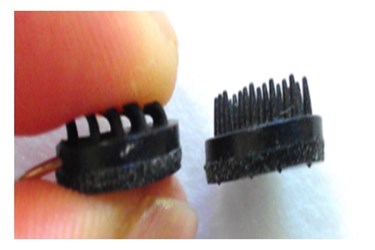Imec And Holst Centre Introduce Polymer Dry Electrodes For Biopotential Measurements Such As EEG And ECG

Breakthrough Result Paves the Way Towards Reliable and Comfortable Remote EEG and ECG Monitoring
Nanoelectronics research center imec, Holst Centre and Datwyler Sealing Solutions, a leading supplier of customer specific sealing, closure and packaging solutions to global market segments, such as the Automotive, Health Care, Civil Engineering and Consumer Goods Industries, will present a novel polymer dry electrode. Soft, flexible, and optimized for skin-impedance noise, polymer dry electrodes are a promising alternative to conventionally used gel electrodes in biopotential signal recording, as well as for uncomfortable and painful dry electrodes with rigid metal pins. At next week’s mHealth Summit 2014 (Dec. 7-11 in Washington, D.C.), imec and Holst Centre will showcase their prototype wireless EEG headset and health patch, demonstrating their innovative technology solutions for remote monitoring (Booth #610).
Current market solutions available include conventional gel electrodes, which are widely used for biopotential measurements such as ECG and EEG monitoring. They are administered during treatment or diagnosis by medical specialists in hospitals, and incur the drawbacks of skin irritation, arduous application and uncomfortable removal. Dry electrodes have also been introduced, and enable wireless biopotential monitoring systems for use outside the domain of the medical specialists during daily activities. However, first generation solutions consist of rigid metal pins that lend to discomfort and pain in patients.
Fabricated from ethylene propylene diene monomer (EPDM) rubber, containing various additives for optimum conductivity, flexibility and ease of fabrication, the polymer dry electrodes offer a high user comfort. Polymer composition is optimized for noise from phantoms and human skin on skin-electrode impedance, resulting in a skin-electrode impedance approximately 10 times greater than that of gel electrodes. The electrodes are directly capable of recording strong biopotential signals such as ECG, and for low-amplitude signals such as EEG.
In relation to EEG signals, the polymer electrodes are coupled with an active circuit, forming a so-called ‘active electrode.’ EEG recordings on imec’s prototype wireless EEG headset using these active polymer electrodes proved very promising results, showing similar performance compared to the performance using metal dry electrodes on imec’s wireless EEG headset. At the same time the comfort of the user is substantially improved when using polymer electrodes.
“Wearable health monitoring holds tremendous opportunities in bringing healthcare to anyone, at any place and at any time. Personal, predictive, and preventive care can improve one’s quality of life in addition to saving lives,” stated Chris Van Hoof, program direct body area networks at imec. “Imec and Holst Centre’s cutting-edge technology, enabling highly accurate and non-invasive monitoring with clinical-grade functionality, paves the way formore efficient and better healthcare.”
About imec
Imec performs world-leading research in nanoelectronics and photovoltaics. Imec leverages its scientific knowledge with the innovative power of its global partnerships in ICT, healthcare and energy. Imec delivers industry-relevant technology solutions. In a unique high-tech environment, its international top talent is committed to providing the building blocks for a better life in a sustainable society. Imec is headquartered in Leuven, Belgium, and has offices in the Netherlands, Taiwan, US, China, India and Japan. Its staff of over 2,080 people includes more than 670 industrial residents and guest researchers. In 2013, imec's revenue (P&L) totaled 332 million euro. For more information, visit www.imec.be.
About Holst Centre
Holst Centre is an independent open-innovation R&D centre that develops generic technologies for Wireless Autonomous Transducer Solutions and for Systems-in-Foil. A key feature of Holst Centre is its partnership model with industry and academia around shared roadmaps and programs. It is this kind of cross-fertilization that enables Holst Centre to tune its scientific strategy to industrial needs.
Holst Centre was set up in 2005 by imec (Flanders, Belgium) and TNO (The Netherlands) with support from the Dutch Ministry of Economic Affairs and the Government of Flanders. It is named after Gilles Holst, a Dutch pioneer in Research and Development and first director of Philips Research.
Located on High Tech Campus Eindhoven, Holst Centre benefits from the state-of-the-art on-site facilities. Holst Centre has over 180 employees from around 28 nationalities and a commitment from more than 45 industrial partners. For more information, visit www.holstcentre.com.
About Datwyler
The Datwyler Group is a focused industrial supplier with leading positions in global and regional market segments. With its technological leadership and customized solutions, the Group delivers added value to customers in the markets served. Datwyler concentrates on markets that offer opportunities to create more value and sustain profitable growth. The Technical Components Division is one of Europe’s foremost high-service distributors of electronic, automation and ICT components and accessories. The Sealing Solutions Division is a leading supplier of customized sealing solutions to global market segments, such as the automotive, health care, civil engineering and consumer goods industries etc. With a total of more than 50 operating companies, sales in over 100 countries and some 6,500 employees, the Datwyler Group generates annual revenue of some CHF 1,300 million. The Group has been listed on the SIX Swiss Exchange since 1986 (security number 3048677).
Source: Imec
